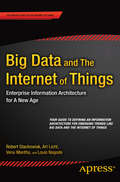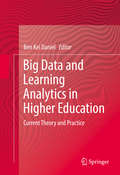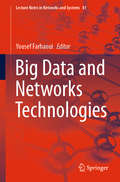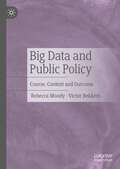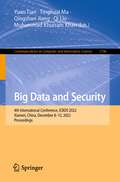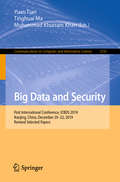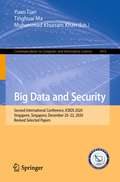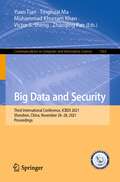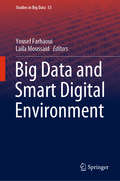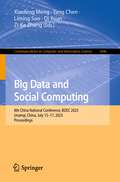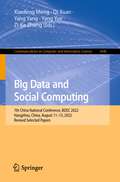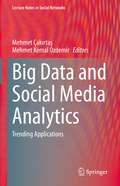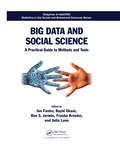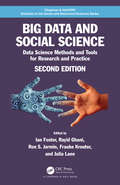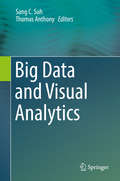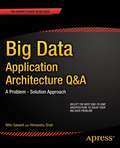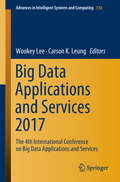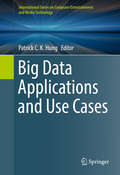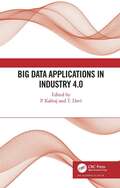- Table View
- List View
Big Data and The Internet of Things: Enterprise Information Architecture for A New Age
by Robert Stackowiak Art Licht Venu Mantha Louis NagodeEnterprise Information Architecture for a New Age: Big Data and The Internet of Things, provides guidance in designing an information architecture to accommodate increasingly large amounts of data, massively large amounts of data, not only from traditional sources, but also from novel sources such everyday objects that are fast becoming wired into global Internet. No business can afford to be caught out by missing the value to be mined from the increasingly large amounts of available data generated by everyday devices.The text provides background as to how analytical solutions and enterprise architecture methodologies and concepts have evolved (including the roles of data warehouses, business intelligence tools, predictive analytics, data discovery, Big Data, and the impact of the Internet of Things). Then you’re taken through a series of steps by which to define a future state architecture and create a plan for how to reach that future state. Enterprise Information Architecture for a New Age: Big Data and The Internet of Things helps you gain an understanding of the following:Implications of Big Data from a variety of new data sources (including data from sensors that are part of the Internet of Things) upon an information architectureHow establishing a vision for data usage by defining a roadmap that aligns IT with line-of-business needs is a key early stepThe importance and details of taking a step-by-step approach when dealing with shifting business challenges and changing technology capabilitiesHow to mitigate risk when evaluating existing infrastructure and designing and deploying new infrastructureEnterprise Information Architecture for a New Age: Big Data and The Internet of Things combines practical advice with technical considerations. Author Robert Stackowiak and his team are recognized worldwide for their expertise in large data solutions, including analytics. Don’t miss your chance to read this book and gain the benefit of their advice as you look forward in thinking through your own choices and designing your own architecture to accommodate the burgeoning explosion in data that can be analyzed and converted into valuable information to drive your business forward toward success.
Big Data and Learning Analytics in Higher Education: Current Theory and Practice
by Ben Kei DanielThis book focuses on the uses of big data in the context of higher education. The book describes a wide range of administrative and operational data gathering processes aimed at assessing institutional performance and progress in order to predict future performance, and identifies potential issues related to academic programming, research, teaching and learning. Big data refers to data which is fundamentally too big and complex and moves too fast for the processing capacity of conventional database systems. The value of big data is the ability to identify useful data and turn it into useable information by identifying patterns and deviations from patterns.
Big Data and Networks Technologies (Lecture Notes in Networks and Systems #81)
by Yousef FarhaouiThis book reviews the state of the art in big data analysis and networks technologies. It addresses a range of issues that pertain to: signal processing, probability models, machine learning, data mining, databases, data engineering, pattern recognition, visualization, predictive analytics, data warehousing, data compression, computer programming, smart cities, networks technologies, etc. Data is becoming an increasingly decisive resource in modern societies, economies, and governmental organizations. In turn, data science inspires novel techniques and theories drawn from mathematics, statistics, information theory, computer science, and the social sciences. All papers presented here are the product of extensive field research involving applications and techniques related to data analysis in general, and to big data and networks technologies in particular. Given its scope, the book will appeal to advanced undergraduate and graduate students, postdoctoral researchers, lecturers and industrial researchers, as well general readers interested in big data analysis and networks technologies.
Big Data and Public Policy: Course, Content and Outcome
by Rebecca Moody Victor BekkersThis book provides a comprehensive overview of how the course, content and outcome of policy making is affected by big data. It scrutinises the notion that big and open data makes policymaking a more rational process, in which policy makers are able to predict, assess and evaluate societal problems. It also examines how policy makers deal with big data, the problems and limitations they face, and how big data shapes policymaking on the ground. The book considers big data from various perspectives, not just the political, but also the technological, legal, institutional and ethical dimensions. The potential of big data use in the public sector is also assessed, as well as the risks and dangers this might pose. Through several extended case studies, it demonstrates the dynamics of big data and public policy. Offering a holistic approach to the study of big data, this book will appeal to students and scholars of public policy, public administration and data science, as well as those interested in governance and politics.
Big Data and Security: 5th International Conference, ICBDS 2023, Nanjing, China, December 22–24, 2023, Revised Selected Papers, Part I (Communications in Computer and Information Science #2099)
by Tinghuai Ma Muhammad Khurram Khan Yuan TianThe two-volume set constitutes the refereed proceedings of the 5th International Conference on Big Data and Security, ICBDS 2023, held in Nanjing, China, during December 22–24, 2023. The 35 full papers and 1 short paper were carefully reviewed and selected from 161 submissions. They are organized in topical sections as follows: Part One: Big Data & New Method and Artificial Intelligence & Machine Learning Part Two: Data Technology & Network Security and IoT Security & Privacy Protection.
Big Data and Security: 5th International Conference, ICBDS 2023, Nanjing, China, December 22–24, 2023, Revised Selected Papers, Part II (Communications in Computer and Information Science #2100)
by Tinghuai Ma Muhammad Khurram Khan Yuan TianThe two-volume set constitutes the refereed proceedings of the 5th International Conference on Big Data and Security, ICBDS 2023, held in Nanjing, China, during December 22–24, 2023. The 35 full papers and 1 short paper were carefully reviewed and selected from 161 submissions. They are organized in topical sections as follows: Part One: Big Data & New Method and Artificial Intelligence & Machine Learning Part Two: Data Technology & Network Security and IoT Security & Privacy Protection.
Big Data and Security: 4th International Conference, ICBDS 2022, Xiamen, China, December 8–12, 2022, Proceedings (Communications in Computer and Information Science #1796)
by Yuan Tian Tinghuai Ma Qingshan Jiang Qi Liu Muhammad Khurram KhanThis book constitutes the refereed proceedings of the 4th International Conference on Big Data and Security, ICBDS 2022, held in Xiamen, China, during December 8–12, 2022.The 51 full papers and 3 short papers included in this book were carefully reviewed and selected from 211 submissions. They were organized in topical sections as follows: answer set programming; big data and new method; intelligence and machine learning security; data technology and network security; sybersecurity and privacy; IoT security.
Big Data and Security: First International Conference, ICBDS 2019, Nanjing, China, December 20–22, 2019, Revised Selected Papers (Communications in Computer and Information Science #1210)
by Yuan Tian Tinghuai Ma Muhammad Khurram KhanThis book constitutes the refereed proceedings of the First International Conference on Big Data and Security, ICBDS 2019, held in Nanjing, China, in December 2019. The 37 revised full papers and 12 short papers were carefully reviewed and selected out of 251 submissions. The papers included in this book cover topics in cybersecurity & privacy, big data, blockchain & internet of things, security in cloud and fog computing, and artificial intelligence/ machine learning security.
Big Data and Security: Second International Conference, ICBDS 2020, Singapore, Singapore, December 20–22, 2020, Revised Selected Papers (Communications in Computer and Information Science #1415)
by Yuan Tian Tinghuai Ma Muhammad Khurram KhanThis book constitutes the refereed proceedings of the Second International Conference on Big Data and Security, ICBDS 2020, held in Singapore, Singapore, in December 2020.The 44 revised full papers and 8 short papers were carefully reviewed and selected out of 153 submissions. The papers included in this book are orfanized according to the topical sections on cybersecurity and privacy, big data, blockchain and internet of things, and artificial intelligence/ machine learning security.
Big Data and Security: Third International Conference, ICBDS 2021, Shenzhen, China, November 26–28, 2021, Proceedings (Communications in Computer and Information Science #1563)
by Yuan Tian Tinghuai Ma Muhammad Khurram Khan Victor S. Sheng Zhaoqing PanThis book constitutes the refereed proceedings of the Third International Conference on Big Data and Security, ICBDS 2021, held in Shenzhen, China, in November 2021The 46 revised full papers and 13 short papers were carefully reviewed and selected out of 221 submissions. The papers included in this volume are organized according to the topical sections on cybersecurity and privacy; big data; blockchain and internet of things, and artificial intelligence/ machine learning security.
Big Data and Smart Digital Environment (Studies in Big Data #53)
by Yousef Farhaoui Laila MoussaidThis book reviews the state of the art of big data analysis and smart city. It includes issues which pertain to signal processing, probability models, machine learning, data mining, database, data engineering, pattern recognition, visualisation, predictive analytics, data warehousing, data compression, computer programming, smart city, etc. Data is becoming an increasingly decisive resource in modern societies, economies, and governmental organizations. Data science inspires novel techniques and theories drawn from mathematics, statistics, information theory, computer science, and social science. Papers in this book were the outcome of research conducted in this field of study. The latter makes use of applications and techniques related to data analysis in general and big data and smart city in particular. The book appeals to advanced undergraduate and graduate students, postdoctoral researchers, lecturers and industrial researchers, as well as anyone interested in big data analysis and smart city.
Big Data and Social Computing: 9th China National Conference, BDSC 2024, Harbin, China, August 8–10, 2024, Proceedings (Communications in Computer and Information Science #2161)
by Xiaofeng Meng Yang Chen Zhidong Cao Suran Wu Xiu-Xiu ZhanThis book constitutes the refereed proceedings of the 9th China National Conference on Big Data and Social Computing, BDSC 2024, held in Harbin, China, during August 8–10, 2024. The 28 full papers presented in this volume were carefully reviewed and selected from a total of 141 submissions. The papers in the volume are organized according to the following topics: digital society and public security; modelling and simulation of social systems; internet intelligent algorithm governance; social network and group behavior; innovation, risks, and network security of large language models; and artificial intelligence and cognitive science.
Big Data and Social Computing: 8th China National Conference, BDSC 2023, Urumqi, China, July 15–17, 2023, Proceedings (Communications in Computer and Information Science #1846)
by Xiaofeng Meng Yang Chen Liming Suo Qi Xuan Zi-Ke ZhangThis book constitutes refereed proceedings of the 8th China National Conference on Big Data and Social Computing, BDSC 2023, held in Urumqi, China, from July 15–17, 2023.The 23 full papers and 3 short papers presented in this volume were carefully reviewed and selected from a total of 141 submissions. The papers in the volume are organized according to the following topical headings: Digital Technology and Sustainable Development; Social Network and Group Behavior; Digital infrastructure and the Intelligent Society; Digital Society and Public Security; Artificial Intelligence and Cognitive Science; and Internet Intelligent Algorithm Governance.
Big Data and Social Computing: 7th China National Conference, BDSC 2022, Hangzhou, China, August 11-13, 2022, Revised Selected Papers (Communications in Computer and Information Science #1640)
by Xiaofeng Meng Qi Xuan Yang Yang Yang Yue Zi-Ke ZhangThis book constitutes refereed proceedings of the 7th China National Conference on Big Data and Social Computing, BDSC 2022, held in Hangzhou, China, from August 11-13, 2022The 24 full papers and 2 short papers presented in this volume were carefully reviewed and selected from a total of 99 submissions. The papers in the volume are organised according to the following topical headings: urban computing and social governance; artificial intelligence and cognitive science; social network and group behavior; digital society and public security; digital government and public big data
Big Data and Social Media Analytics: Trending Applications (Lecture Notes in Social Networks)
by Mehmet Çakırtaş Mehmet Kemal OzdemirThis edited book provides techniques which address various aspects of big data collection and analysis from social media platforms and beyond. It covers efficient compression of large networks, link prediction in hashtag graphs, visual exploration of social media data, identifying motifs in multivariate data, social media surveillance to enhance search and rescue missions, recommenders for collaborative filtering and safe travel plans to high risk destinations, analysis of cyber influence campaigns on YouTube, impact of location on business rating, bibliographical and co-authorship network analysis, and blog data analytics. All these trending topics form a major part of the state of the art in social media and big data analytics. Thus, this edited book may be considered as a valuable source for readers interested in grasping some of the most recent advancements in this high trending domain.
Big Data and Social Science: A Practical Guide to Methods and Tools (Chapman & Hall/CRC Statistics in the Social and Behavioral Sciences)
by Ian Foster Rayid Ghani Ron S. Jarmin Frauke Kreuter Julia LaneBoth Traditional Students and Working Professionals Acquire the Skills to Analyze Social Problems. Big Data and Social Science: A Practical Guide to Methods and Tools shows how to apply data science to real-world problems in both research and the practice. The book provides practical guidance on combining methods and tools from computer science, statistics, and social science. This concrete approach is illustrated throughout using an important national problem, the quantitative study of innovation. The text draws on the expertise of prominent leaders in statistics, the social sciences, data science, and computer science to teach students how to use modern social science research principles as well as the best analytical and computational tools. It uses a real-world challenge to introduce how these tools are used to identify and capture appropriate data, apply data science models and tools to that data, and recognize and respond to data errors and limitations. For more information, including sample chapters and news, please visit the author's website.
Big Data and Social Science: Data Science Methods and Tools for Research and Practice (Chapman & Hall/CRC Statistics in the Social and Behavioral Sciences)
by Ian Foster Rayid Ghani Ron S. Jarmin Frauke Kreuter Julia LaneBig Data and Social Science: Data Science Methods and Tools for Research and Practice, Second Edition shows how to apply data science to real-world problems, covering all stages of a data-intensive social science or policy project. Prominent leaders in the social sciences, statistics, and computer science as well as the field of data science provide a unique perspective on how to apply modern social science research principles and current analytical and computational tools. The text teaches you how to identify and collect appropriate data, apply data science methods and tools to the data, and recognize and respond to data errors, biases, and limitations. Features: Takes an accessible, hands-on approach to handling new types of data in the social sciences Presents the key data science tools in a non-intimidating way to both social and data scientists while keeping the focus on research questions and purposes Illustrates social science and data science principles through real-world problems Links computer science concepts to practical social science research Promotes good scientific practice Provides freely available workbooks with data, code, and practical programming exercises, through Binder and GitHub New to the Second Edition: Increased use of examples from different areas of social sciences New chapter on dealing with Bias and Fairness in Machine Learning models Expanded chapters focusing on Machine Learning and Text Analysis Revamped hands-on Jupyter notebooks to reinforce concepts covered in each chapter This classroom-tested book fills a major gap in graduate- and professional-level data science and social science education. It can be used to train a new generation of social data scientists to tackle real-world problems and improve the skills and competencies of applied social scientists and public policy practitioners. It empowers you to use the massive and rapidly growing amounts of available data to interpret economic and social activities in a scientific and rigorous manner.
Big Data and Social Science: Data Science Methods and Tools for Research and Practice (Chapman & Hall/CRC Statistics in the Social and Behavioral Sciences)
by Ian Foster, Rayid Ghani, Ron S. Jarmin, Frauke Kreuter and Julia LaneBig Data and Social Science: Data Science Methods and Tools for Research and Practice, Second Edition shows how to apply data science to real-world problems, covering all stages of a data-intensive social science or policy project. Prominent leaders in the social sciences, statistics, and computer science as well as the field of data science provide a unique perspective on how to apply modern social science research principles and current analytical and computational tools. The text teaches you how to identify and collect appropriate data, apply data science methods and tools to the data, and recognize and respond to data errors, biases, and limitations. Features: Takes an accessible, hands-on approach to handling new types of data in the social sciences Presents the key data science tools in a non-intimidating way to both social and data scientists while keeping the focus on research questions and purposes Illustrates social science and data science principles through real-world problems Links computer science concepts to practical social science research Promotes good scientific practice Provides freely available workbooks with data, code, and practical programming exercises, through Binder and GitHub New to the Second Edition: Increased use of examples from different areas of social sciences New chapter on dealing with Bias and Fairness in Machine Learning models Expanded chapters focusing on Machine Learning and Text Analysis Revamped hands-on Jupyter notebooks to reinforce concepts covered in each chapter This classroom-tested book fills a major gap in graduate- and professional-level data science and social science education. It can be used to train a new generation of social data scientists to tackle real-world problems and improve the skills and competencies of applied social scientists and public policy practitioners. It empowers you to use the massive and rapidly growing amounts of available data to interpret economic and social activities in a scientific and rigorous manner.
Big Data and Visual Analytics
by Sang C. Suh Thomas AnthonyThis book provides users with cutting edge methods and technologies in the area of big data and visual analytics, as well as an insight to the big data and data analytics research conducted by world-renowned researchers in this field. The authors present comprehensive educational resources on big data and visual analytics covering state-of-the art techniques on data analytics, data and information visualization, and visual analytics. Each chapter covers specific topics related to big data and data analytics as virtual data machine, security of big data, big data applications, high performance computing cluster, and big data implementation techniques. Every chapter includes a description of an unique contribution to the area of big data and visual analytics. This book is a valuable resource for researchers and professionals working in the area of big data, data analytics, and information visualization. Advanced-level students studying computer science will also find this book helpful as a secondary textbook or reference.
Big Data Application Architecture Q&A: A Problem - Solution Approach
by Nitin Sawant Himanshu ShahBig Data Application Architecture Pattern Recipes provides an insight into heterogeneous infrastructures, databases, and visualization and analytics tools used for realizing the architectures of big data solutions. Its problem-solution approach helps in selecting the right architecture to solve the problem at hand. In the process of reading through these problems, you will learn harness the power of new big data opportunities which various enterprises use to attain real-time profits. Big Data Application Architecture Pattern Recipes answers one of the most critical questions of this time 'how do you select the best end-to-end architecture to solve your big data problem?'.The book deals with various mission critical problems encountered by solution architects, consultants, and software architects while dealing with the myriad options available for implementing a typical solution, trying to extract insight from huge volumes of data in real–time and across multiple relational and non-relational data types for clients from industries like retail, telecommunication, banking, and insurance. The patterns in this book provide the strong architectural foundation required to launch your next big data application. The architectures for realizing these opportunities are based on relatively less expensive and heterogeneous infrastructures compared to the traditional monolithic and hugely expensive options that exist currently. This book describes and evaluates the benefits of heterogeneity which brings with it multiple options of solving the same problem, evaluation of trade-offs and validation of 'fitness-for-purpose' of the solution.
Big Data Applications and Services 2017: The 4th International Conference on Big Data Applications and Services (Advances in Intelligent Systems and Computing #770)
by Wookey Lee Carson K. LeungThis proceedings volume contains selected papers from the Fourth International Conference on Big Data Applications and Services (BigDAS 2017), held in Tashkent, Uzbekistan on August 15-18, 2017. Big data has become a core technology providing innovative solutions in many fields including social media, healthcare and manufacturing. The Fourth International Conference on Big Data Applications and Services (BigDAS 2017) presented innovative results, encouraged academic and industrial interaction, and promoted collaborative research in the field of big data worldwide. The conference was organized by the Korea Big Data Services Society and National University of Uzbekistan.
Big Data Applications and Use Cases (International Series on Computer Entertainment and Media Technology)
by Patrick C. K. HungThis book presents different use cases in big data applications and related practical experiences. Many businesses today are increasingly interested in utilizing big data technologies for supporting their business intelligence so that it is becoming more and more important to understand the various practical issues from different practical use cases. This book provides clear proof that big data technologies are playing an ever increasing important and critical role in a new cross-discipline research between computer science and business.
Big Data Applications in Industry 4.0
by P. KalirajIndustry 4.0 is the latest technological innovation in manufacturing with the goal to increase productivity in a flexible and efficient manner. Changing the way in which manufacturers operate, this revolutionary transformation is powered by various technology advances including Big Data analytics, Internet of Things (IoT), Artificial Intelligence (AI), and cloud computing. Big Data analytics has been identified as one of the significant components of Industry 4.0, as it provides valuable insights for smart factory management. Big Data and Industry 4.0 have the potential to reduce resource consumption and optimize processes, thereby playing a key role in achieving sustainable development. Big Data Applications in Industry 4.0 covers the recent advancements that have emerged in the field of Big Data and its applications. The book introduces the concepts and advanced tools and technologies for representing and processing Big Data. It also covers applications of Big Data in such domains as financial services, education, healthcare, biomedical research, logistics, and warehouse management. Researchers, students, scientists, engineers, and statisticians can turn to this book to learn about concepts, technologies, and applications that solve real-world problems. Features An introduction to data science and the types of data analytics methods accessible today An overview of data integration concepts, methodologies, and solutions A general framework of forecasting principles and applications, as well as basic forecasting models including naïve, moving average, and exponential smoothing models A detailed roadmap of the Big Data evolution and its related technological transformation in computing, along with a brief description of related terminologies The application of Industry 4.0 and Big Data in the field of education The features, prospects, and significant role of Big Data in the banking industry, as well as various use cases of Big Data in banking, finance services, and insurance Implementing a Data Lake (DL) in the cloud and the significance of a data lake in decision making
Big Data Applications in Industry 4.0
by P. Kaliraj Devi ThirupathiIndustry 4.0 is the latest technological innovation in manufacturing with the goal to increase productivity in a flexible and efficient manner. Changing the way in which manufacturers operate, this revolutionary transformation is powered by various technology advances including Big Data analytics, Internet of Things (IoT), Artificial Intelligence (AI), and cloud computing. Big Data analytics has been identified as one of the significant components of Industry 4.0, as it provides valuable insights for smart factory management. Big Data and Industry 4.0 have the potential to reduce resource consumption and optimize processes, thereby playing a key role in achieving sustainable development. Big Data Applications in Industry 4.0 covers the recent advancements that have emerged in the field of Big Data and its applications. The book introduces the concepts and advanced tools and technologies for representing and processing Big Data. It also covers applications of Big Data in such domains as financial services, education, healthcare, biomedical research, logistics, and warehouse management. Researchers, students, scientists, engineers, and statisticians can turn to this book to learn about concepts, technologies, and applications that solve real-world problems. Features An introduction to data science and the types of data analytics methods accessible today An overview of data integration concepts, methodologies, and solutions A general framework of forecasting principles and applications, as well as basic forecasting models including naïve, moving average, and exponential smoothing models A detailed roadmap of the Big Data evolution and its related technological transformation in computing, along with a brief description of related terminologies The application of Industry 4.0 and Big Data in the field of education The features, prospects, and significant role of Big Data in the banking industry, as well as various use cases of Big Data in banking, finance services, and insurance Implementing a Data Lake (DL) in the cloud and the significance of a data lake in decision making
Big Data Architect's Handbook: A guide to building proficiency in tools and systems used by leading big data experts
by Syed Muhammad AkhtarA comprehensive end-to-end guide that gives hands-on practice in big data and Artificial Intelligence Key Features Learn to build and run a big data application with sample code Explore examples to implement activities that a big data architect performs Use Machine Learning and AI for structured and unstructured data Book Description The big data architects are the “masters” of data, and hold high value in today's market. Handling big data, be it of good or bad quality, is not an easy task. The prime job for any big data architect is to build an end-to-end big data solution that integrates data from different sources and analyzes it to find useful, hidden insights. Big Data Architect's Handbook takes you through developing a complete, end-to-end big data pipeline, which will lay the foundation for you and provide the necessary knowledge required to be an architect in big data. Right from understanding the design considerations to implementing a solid, efficient, and scalable data pipeline, this book walks you through all the essential aspects of big data. It also gives you an overview of how you can leverage the power of various big data tools such as Apache Hadoop and ElasticSearch in order to bring them together and build an efficient big data solution. By the end of this book, you will be able to build your own design system which integrates, maintains, visualizes, and monitors your data. In addition, you will have a smooth design flow in each process, putting insights in action. What you will learn Learn Hadoop Ecosystem and Apache projects Understand, compare NoSQL database and essential software architecture Cloud infrastructure design considerations for big data Explore application scenario of big data tools for daily activities Learn to analyze and visualize results to uncover valuable insights Build and run a big data application with sample code from end to end Apply Machine Learning and AI to perform big data intelligence Practice the daily activities performed by big data architects Who this book is for Big Data Architect's Handbook is for you if you are an aspiring data professional, developer, or IT enthusiast who aims to be an all-round architect in big data. This book is your one-stop solution to enhance your knowledge and carry out easy to complex activities required to become a big data architect.
